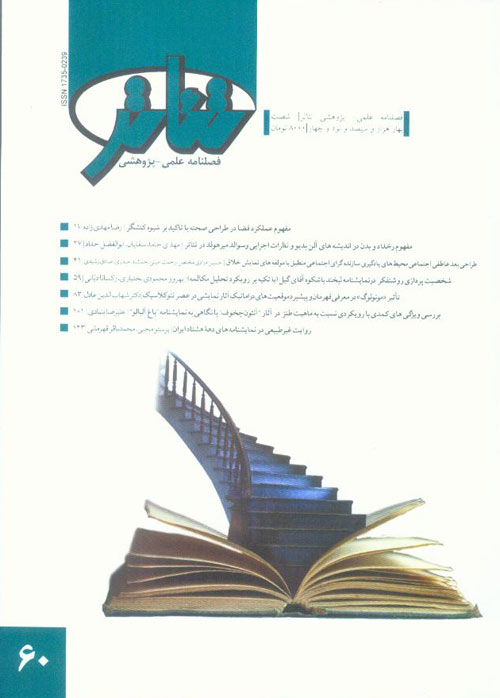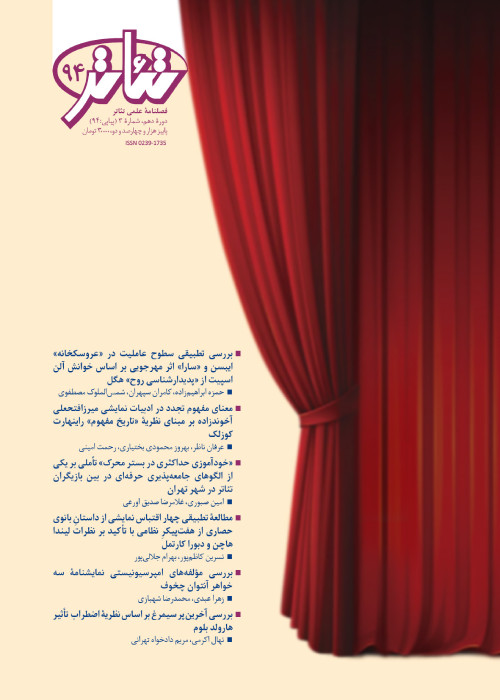فهرست مطالب

نشریه تئاتر
سال دوم شماره 60 (بهار 1394)
- 152 صفحه، بهای روی جلد: 80,000ريال
- تاریخ انتشار: 1394/10/25
- تعداد عناوین: 8
-
-
صفحه 7
-
Page 11Today what is mentioned as space is the outcome of theoretical definitions in the philosophers and clear sighted opinions and theories of art and architecture history, especially in 20th century. Contemplating nature of this concept and its function perception requires the nature studying regarding opinions and experiences that have a big portion in concept evolution of it. This article which is on the basis of analytical – descriptive research and based on library studies, tries to survey and specify the concept of space and the function of action design by studying it in this method. This article is presented in two principal parts; in the first part, thought and concepts of action design, is studied. In this part, mental infrastructure is interpreted on the basis of words and basic idioms of this method. In the second part, we try to interpret and specify the concept of space function in this method on the basis of action designers’ opinions and thoughts. Up to the studies done, it can be concluded that by understanding features such as group work and exploration to find out new dramatic rules, discarding common visual aesthetics for the sake of act aesthetics and changing all theater spaces completely in accordance with scene requirements, it is possible to create effective capacities and motivations in dramatic works production.Keywords: action design, act, space, function
-
Page 25Alain Badiou is one of the most distinguished thinkers of contemporary world that seek the possibility of philosophy manifestation in the four conditions of politics, love, art and science. According to his view, philosophy acts based on multiple truth that are both the source and goal of the philosophy. The foundation and major part of those truths manifest in the core of events that take place in specific times and places. Efforts to understand and perceive those eventful situations led Badiou to seek innovations mixed with radical potentials. In this area, among various arts Vsevolod Meyerhold has found a unique place for Badiou in the theater arena. This paper discusses on how the concept of event in Badiou’s thoughts is connected with approaches of Meyerhold in theater. In addition, emphasis is made on how in Badiou’s philosophy, body has changed into an essential element that finds compatibility with the body-based theater of Meyerhold; that is, biomechanics. This research has been developed by using descriptive-analytical methods and by using literature review and internet sources.Keywords: Alain Badiou, Vsevolod Meyerhold, biomechanics, event, Body
-
Page 39Designing cognitive and psycho-motor aspects always have priority on designing social-emotional aspects and to a large extent we can say that educational designing of social-emotional aspects are forgotten. Since different parts of education are linked together and the creation of favorable educational outcomes such as problem-solving and creativity needs to attention to each of the cognitive, psychological, Physical and emotional Social, so this study aims to provide guidelines for designing social-emotional aspects of social constructing of learning environments based on Creative Drama, which is a multi-sensory and interactive media. The method used in this research is descriptive and analytical-based strategy.Keywords: Design of learning environments, Emotional, social, Social constructivism, Creative Drama
-
Page 57The pivoted role of language in dramatic texts has prioritized the presence of Stylistics_ an interdisciplinary area of pragmatics and literary criticism_ as professional methods of investigation and examination in dramatic discourse. One of the profound frameworks that this specialist area has introduced is Conversation Analysis. Conversation Analysis itself sets out some concepts and rules like turn-taking system, turn-sequencing and distribution organizations in order to facilitate researchers’ attempt at accessing and understanding characters in their different conversational behaviors. In the present study, intellectual competitions of the intellectual character, Jamshid, in Akbar Radi’s Labkhande Bashokoohe Aghaye Gil (1352) are examined through applying Conversation Analysis’ rules and concepts proposed by Schegloff and Levinson. Moreover, it explores that the frequency of performing different kinds of dispreferred sequences done by intellectual character indicates his reluctance to demonstrate compatibility and to seek reconciliation and peace with the opposite party with whom he has attempted to struggle.Keywords: Conversation Analysis, Turn, taking System, Turn, sequencing Organization, Akbar Radi, Labkhande Bashokoohe Aghaye Gil
-
Page 81This article is an analytic look on monologue category and its role in introducing the characterization of the protagonist and creating dramatic situations in drama that will be discussed through structuralist approach in the three tragedies of neo-classical age. The purpose of this article is: 1) the role of monologue in drama, 2) The operational effect of monologue in creating dramatic opportunities as well as characterization, 3) the communication of monologue with the audience besides the contact of audience with the process of drama events, 4) the role of monologue in the emergence of other dramatic techniques. On the other hand, monologue in drama has more capabilities in storytelling such as diverse discourses about individuality and the way it reveals psychological and inner qualities of the characters and reflects the language and culture of a society. Furthermore its diverse functions made performance arts a great touch ahead. Although monologue refer to the words a person says to him/herself or the audience, but this term and its functions and employing methods is partly different from each other in different periods of dramatic literature in the world; somehow the methods, approaches and views of employing monologue in classic age is different from modern age and even post-modern, considering this method in classic period was used as a requirement versus in modern period as a technique or artifice.Keywords: Monologue, Dramatic Structure, Classic, Neo, Classic, Characterization, Monodrama
-
Page 99Chekhov’s humor is characterized by the role of his characters and their worldviews in his dramas. Characters inChekhov’s dramas while being funny in some moments create a feeling of pity in the audience. This is the case with the most of characters created by Chekhov. On the other hand, he does not distinguish between the main and secondary characters as there is no inclination to heroism in his works. Characters are displayed in Chekhov’s dramatic works in an uncertain state when they are involved in creating unintentional incidents and events. Such uncertainty as a feature results in the funny and satiric situations. An awareness of this feature is of high importance for analyzing and performing Chekhov’s plays. This is a contradictory situation as the analyst or the performer is likely to be dragged into comedy or involved in tragedy on one hand or in comedy and humor in the other extreme. Having a serious look at the characters’ worldviews, this article explores Chekhov’s humor in his dramatic works and its findings can be used to avoid one of serious pathologies in analyzing and even reproducing his dramas and plays and eliminate misconceptions about the nature of humor in his works. For instance, exaggerating in creating comedies without a regard for the comic aspect of Chekhov’s dramas can affect negatively the analysis or the performance of such works and event create a false impression of the Chekhov’s humor and downgrade it to a kind of lampoon. As such, the present study by providing an analysis of comic features and especially humor in Chekhov’s drama with an emphasis on how characters are created, attempts to offer some implications and shed light into the nature of humor in his works. Accordingly, an exploratory-interpretive analysis is employed to assess the comic features in Chekhov’s dramatic works. The research model is “Cherry Orchard”, one of the eminent Chekhov’s plays, which probably can serve as the best source of data for exploring satiric features in the writer’s works. To this end, a library and a priori research method is used to assess the opinions based on the research model and provide the conclusions.Keywords: Anton Chekhov, humor, comedy, character, Cherry Orchard
-
Page 121Unnatural narrative entered the field of narratological studies since the early years of the current century, being theorized and classified by narratologists like Jan Alber and Brian Richardson. Unnatural narratology, unlike natural narratology, focuses on non-realistic and anti-mimetic narrative elements and attempts to provide a more comprehensive pattern for the study of those narratives that do not obey the arbitrary patterns of representation. In other words, they do not recreate the world as it is perceived on the basis of common sense experience. Since the 1380s, Persian playwrights have indicated a growing interest in the reflection of unnatural elements in their works. They represent elements such as time, space, character, and narrator differently from real-world experience and in the structure of their narrative they present what is physically and/or logically impossible. The present study is a descriptive-analytical exploration of the strategies used by Persian well known playwrights like Samini, Charmshir, and Amjad in the 1380s to transgress the realistic borders and to represent mental territories. These strategies challenge the readers’ expectations of the familiarized structure of the world and provide them with different ways of experiencing it by applying fundamental changes to the narrative elements of the work. Referring to Alber’s theories, the paper provides recommendations for reading these texts to indicate how readers attempt to understand such scenarios and expand their mental architecture to naturalize them.Keywords: Unnatural Narrative, Persian Drama of the 1380s, Narratology, Natural Narratology, Jan Alber, Persian Play


